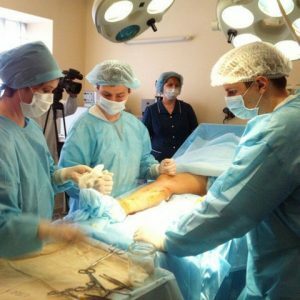Iron deficiency anemia: causes, symptoms and treatment
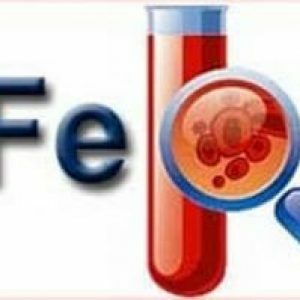
Iron deficiency anemia is a blood disease characterized by inadequate intake of iron or a violation of its utilization.This pathological condition is not a primary disease, since its appearance is always due to some kind of pathology.Iron deficiency anemia is considered the most common pathology of the blood system, according to the World Health Organization, this disease often affects the fairer sex, which is associated with pregnancy, breast-feeding and blood loss during menstruation.
Table of contents:Iron deficiency anemia: causes of development
Doctors identify several major factors that may lead to the development of the condition in question.
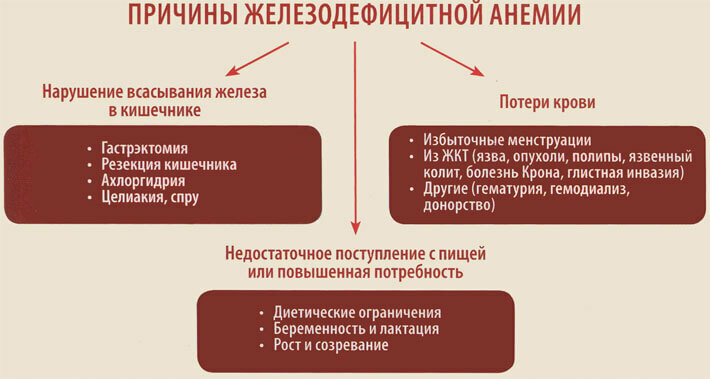
Inadequate intake of iron with food
A malnutrition can lead to the development of iron deficiency anemia at any age, especially the often observed pathological condition is noted with prolonged starvation, vegetarianism provided an unbalanced diet, a monotonous diet with a minimum content of animal products.
Note: in a newborn child, iron deficiency anemia is excluded if it is breastfed and the mother does not have anemia.If the baby is too early transferred for artificial feeding, iron deficiency anemia can develop even at such a small age.
Elevated body requirements for iron
 These are conditions such as pregnancy or the period of lactation of a child .And this despite the fact that during pregnancy, part of the iron is stored in the body, since there are no monthly bleeding!And the development of iron deficiency anemia during pregnancy is associated with the fact that the mother's organism passes this valuable microelement to the fetus, and the placenta needs it.Then during labor and in the postpartum period, blood loss occurs, which also leads to a decrease in the level of iron in the body.
These are conditions such as pregnancy or the period of lactation of a child .And this despite the fact that during pregnancy, part of the iron is stored in the body, since there are no monthly bleeding!And the development of iron deficiency anemia during pregnancy is associated with the fact that the mother's organism passes this valuable microelement to the fetus, and the placenta needs it.Then during labor and in the postpartum period, blood loss occurs, which also leads to a decrease in the level of iron in the body.
Congenital iron deficiency in the body
This factor may be associated with severe iron deficiency anemia in the mother, multiple pregnancies and the birth of a premature baby.In all these cases, the concentration of iron in the blood of the newborn will be low, and the symptoms of the disease in question will be present from the first days of life.
Absorption of iron absorption
A full absorption of iron in the duodenum will only occur if the mucosa of this part of the intestine functions normally.If a person has diseases of the gastrointestinal tract, it will provoke damage to the intestinal mucosa, which will lead to a decrease in the rate of iron intake into the body.
To similar diseases that lead to violations of iron absorption include :
- inflammation of the mucosa of the small intestine - enteritis;
- autoimmune gastritis;
- removal of the stomach and / or small intestine in the anamnesis;
- gluten intolerance - celiac disease;
- atrophic processes in the gastric mucosa - atrophic gastritis;
- is an autoimmune disease associated with damage to the mucosa of the entire intestine and other internal organs - Crohn's disease;
- a violation of the secretion of all the glands of the hereditary organism - cystic fibrosis;
- malignant neoplasms of the stomach and / or duodenum.
Disruption of transferrin synthesis
Such disorders can be associated with various hereditary diseases, but there will be no symptoms of iron deficiency anemia in the newborn, since this important trace element will enter the body with breast milk.
It should be noted that transferrin is synthesized exclusively in liver cells, therefore its various pathologies( hepatitis, cirrhosis) also lead to the development of iron deficiency anemia.
Increased blood loss
If a single loss of even a large amount of blood has occurred, this usually does not lead to the development of iron deficiency anemia - iron stores in the body are enough to compensate for blood loss.At the same time, with minor but persistent bleeding per day, several milligrams of iron are lost and this is fraught with serious consequences.
Causes of chronic blood loss can be:
-
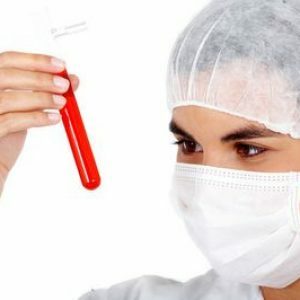 hemorrhoids in the acute stage;
hemorrhoids in the acute stage; - systemic lupus erythematosus;
- intestinal polyposis;
- systemic vasculitis;
- peptic ulcer of the stomach and / or duodenum;
- Crohn's disease;
- endometriosis;
- ulcerative colitis of a nonspecific character;
- tumors of the gastrointestinal tract in the stage of disintegration.
If the cause of permanent blood loss is not diagnosed in time, then this necessarily leads to the development of iron deficiency anemia.
Alcoholism
Damage to the gastric mucosa occurs with prolonged use of alcohol in large quantities.This is due, first of all, to the ingestion of ethyl alcohol, which is contained in any alcoholic beverages.In addition, ethyl alcohol has a depressing effect on the processes of hematopoiesis in the red bone marrow, and this also causes the development of the disease in question.
Taking medications
As a rule, iron deficiency anemia occurs when taking medications only if this method was long and the medicines were taken in large quantities. The most common disease is the following:
- non-steroidal anti-inflammatory drugs - for example, Aspirin;
- antacids - for example, Almagel or Rennie;
- iron-binding - Eksidzhad, Desferal.
Please note: doctors constantly remind their patients that the above medications can not be taken without the appointment of a specialist and can independently adjust the duration and dosage of .
Symptoms of iron deficiency anemia
It should be noted that the disease under consideration does not manifest itself immediately, it can be asymptomatic for a long time - a person leads a normal life, does not feel any discomfort, although the level of iron in the body is already reduced.In the elderly and childhood, on the contrary, the clinical picture with iron deficiency anemia will be pronounced literally from the first days of the disease. In any case, the symptoms of iron deficiency anemia are identical:
- dyspnea;
- a violation of taste and smell;
- predisposition to infectious diseases;
- mucosal lesions( eg, ulcers of the stomatitis type may appear in the oral cavity);
- infringements of intellectual development - concentration of attention is reduced, the child starts to master poorly the educational material, the memory decreases;
- language damage;
- increased fatigue;
- skin changes( flaking and redness) and nails / hair( stratification, prolapse);
- muscle weakness.
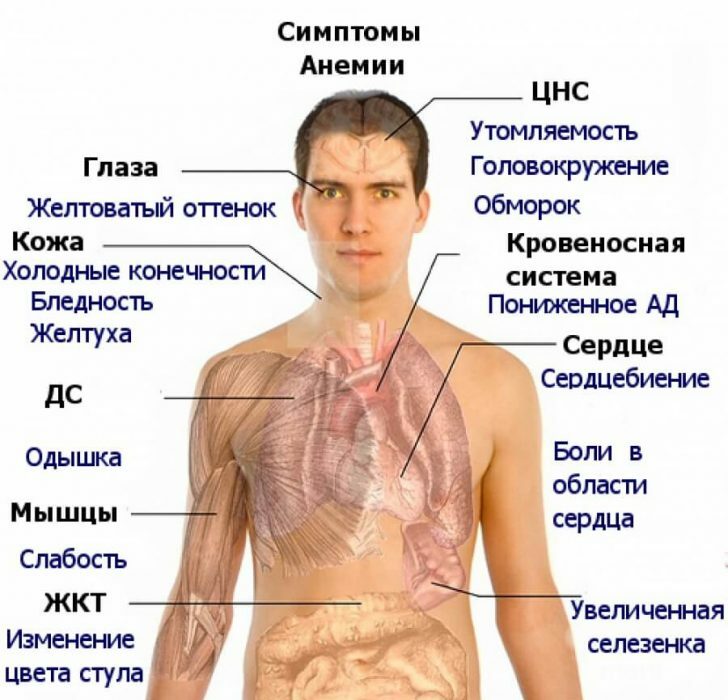
Diagnostic measures
In principle, a doctor of any direction can suspect the development of the disease in question.But the diagnosis of anemia, the severity of its course and treatment is done by a hematologist.
Diagnostics of iron deficiency anemia is not only an analysis of the patient's questioning, but also laboratory blood tests, bone marrow puncture( rarely done, but very informative).If it is a question of establishing the cause of the development of iron deficiency anemia, the patient may be assigned a study of feces for latent blood and if the analysis gives a positive result, this will mean that the body has either a disintegrating tumor, or a peptic ulcer, or Crohn's disease develops.
In the diagnosis of iron deficiency anemia, the hematologist necessarily invites the oncologist, surgeon, gynecologist, gastroenterologist, endocrinologist to consult - these specialists help establish the true causes of the disease in question and prescribe adequate therapy.
Treatment of iron deficiency anemia
The process is not fast, the patient will not only have to take specific medications, but also perform a correction of nutrition.
Diet for iron deficiency anemia
On our site there is already a full-fledged article about what products you need to use for the disease in question.We just recall that the maximum complete absorption of iron by the body comes from meat products - they should be the basis of the diet.In the menu of the patient, iron deficiency anemia must include liver pork and chicken, rabbit and chicken meat, cottage cheese and cow's milk, egg yolk and beef / lamb, sea kale and prunes, rose hips and sunflower seeds, buckwheat and peaches, apples and almonds.
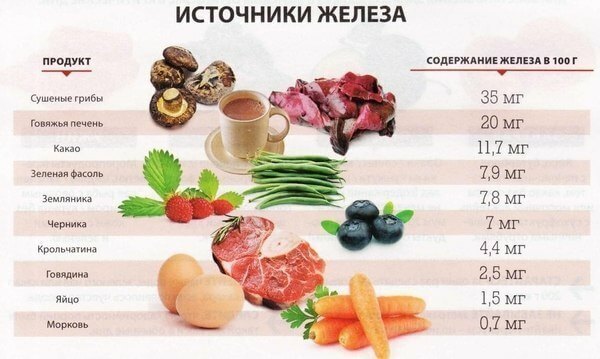
Nutrition for the disease in question must necessarily be full, that is, fixate only on these products can not be - the menu should include fish and seafood, and vegetables with fruits / berries, and a variety of cereals and sour-milk products.
Note: , despite the fact that the diet is able to adjust the amount of iron in the body, it is not able to rid the body of the deficiency of this important trace element.Therefore, doctors warn about the need for specific medications.
Medication Therapy
The choice of doctors in the treatment of iron deficiency anemia falls on the tablet form of medications.Intravenous and intramuscular administration of drugs is possible, but is more often used when it is necessary to quickly fill the loss of iron( for example, with heavy bleeding) or a violation of absorption of iron by the intestine.
Among all the medicines that are used to treat iron deficiency anemia, we can distinguish the following:
-
 Hemofluor prolongatum.It is taken orally for an hour before or 2 hours after a meal, each tablet is washed down with a large amount of water.The duration of treatment with this drug is 4-6 months, and after normalization of the level of iron in the body for another 2-3 months take maintenance doses.
Hemofluor prolongatum.It is taken orally for an hour before or 2 hours after a meal, each tablet is washed down with a large amount of water.The duration of treatment with this drug is 4-6 months, and after normalization of the level of iron in the body for another 2-3 months take maintenance doses. - Sorbifer Durules.It is taken orally for half an hour before meals, washed down with a glass of water.It is often prescribed to pregnant women with iron deficiency anemia.The duration of the course of admission is individual and determined by the positive dynamics.
- Ferro-foil.It is taken orally, half an hour before meals twice a day.The duration of the course of admission is 1-4 months, more specific terms are set by the attending physician, based on the results of blood control tests.
Note: , some medicines have the ability to improve or impair iron absorption by the body.Therefore, with simultaneous intake of iron-containing drugs and such "variable" drugs, it should be borne in mind that ascorbic / succinic acid, fructose and sorbitol, cysteine and nicotinamide improve iron absorption, while calcium salts and phosphates, tetracyclines and tannins, antacids and phytines - reduce absorption.
We recommend reading:Prognosis of iron deficiency anemia, as a rule, favorable - recovery occurs relatively quickly.Of course, some factors can lead to difficulties in the treatment of iron deficiency anemia - for example, an incorrectly diagnosed diagnosis, a dysregulation and a medication regimen, a late-onset treatment. But in this case, the development of complications of iron deficiency anemia is possible:
- is a lag in growth and development, which is especially characteristic for childhood;
- anemic coma;
- complications of an infectious nature;
- deficiency of internal organs.
Iron deficiency anemia is a disease that under conditions of modern medicine is well treated.But for this you need to identify this problem in time and get effective appointments from a specialist.
Tsygankova Yana Aleksandrovna, medical reviewer, therapist of the highest qualification category


